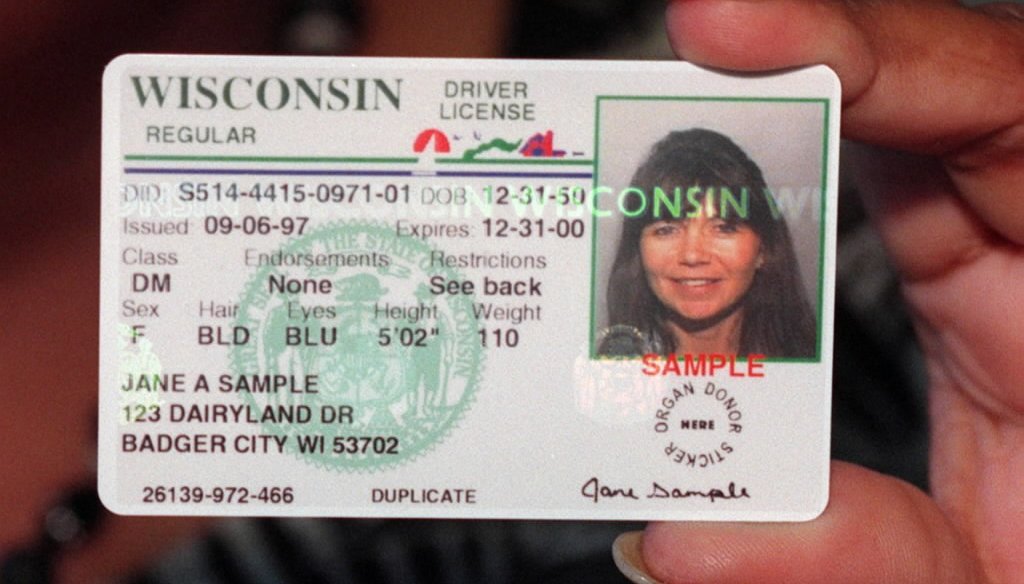



The 2016 presidential election was the first in Wisconsin in which a photo identification was required to vote.
While reflecting on the 2016 presidential election, Hillary Clinton was asked why she didn’t campaign more in Wisconsin -- a state that hadn’t gone Republican since 1984, but one she lost to Donald Trump.
Appearing May 31, 2017 at a conference in California sponsored by the Vox Media site Recode, Clinton replied by saying "we thought we were doing really well in Wisconsin," but that "our information was not as reliable as I wished it had been."
Then the former Democratic nominee pivoted to another issue, contending that Wisconsin’s law requiring photo identification to vote caused voter suppression.
"The best estimate is that 200,000 people in Wisconsin were either denied or chilled in their efforts to vote," she said. "I don’t think we believed at the time, before the election, that it would be anything like that, anything as big as that."
Clinton’s claim is similar to one by U.S. Sen. Tammy Baldwin, D-Wis., that we rated Mostly False.
(The Washington Post Fact Checker later gave Baldwin three Pinocchios for the claim.)
Baldwin’s claim
Baldwin flatly stated that turnout in Wisconsin "was reduced by approximately 200,000 votes because of" the photo ID requirement.
The 2016 contest was the first presidential election in which the law was in effect. Baldwin cited a May 2017 report commissioned by Priorities USA Action, a political action committee that supported Clinton and Barack Obama. When we contacted a spokesman at the Democratic National Committee, asking for information to support Clinton’s claim, he referred us to the same report.
Comparing the 2012 and 2016 elections, the report said that on average, turnout increased 1.3 percent in states in which there was no change to voter ID laws, but decreased 3.3 percent in Wisconsin.
Had Wisconsin’s photo ID law not been in effect, the report argues, Wisconsin’s turnout would have been 200,000 votes higher, based on the average increase of 1.3 percent.
Experts told us the methodology is lacking.
Put simply: The voter ID requirement undoubtedly prevented or discouraged some individual people from voting. But the report attributes all of the lower turnout to the ID law, when there are many other reasons that could also explain it, including a lack of enthusiasm for Clinton or Trump, or perhaps a belief that Trump couldn’t win Wisconsin.
Clinton’s statement isn’t as bold as Baldwin’s, in that she refers to an estimate. But that doesn’t change the fact that the methodology used to make that estimate, as we detailed in the Baldwin fact check, has been widely criticized.
A final note from Barry Burden, director of the Elections Research Center at the University of Wisconsin-Madison. He noted that Trump earned almost the same number of votes in Wisconsin as did Mitt Romney, the 2012 GOP nominee.
"Clinton, in contrast, earned 238,000 fewer voters than did Obama," he said. "It would be a mistake to attribute essentially all of that decline to the voter ID requirement."
Our rating
Clinton said: "The best estimate is that 200,000 people in Wisconsin were either denied or chilled in their efforts to vote" in the 2016 presidential election.
A report three weeks earlier from a group that supports Democratic candidates says a decline in voter turnout between the 2012 and 2016 presidential elections in Wisconsin was entirely due to the state’s new photo identification requirement for voting.
But experts say that while photo ID requirements may reduce turnout to some extent, they question the methodology of the report and say there is no way to put a number on how many people in Wisconsin didn’t vote because of the ID requirement.
We rate Clinton’s statement Mostly False.
Recode.net, Transcript of Hillary Clinton remarks, May 31, 2017
Email, Democratic National Committee spokesman Michael Tyler, June 8, 2017
PolitiFact Wisconsin, "Did first-time use of photo ID cause 200,000 drop in Wisconsin voter turnout in presidential race?" May 24, 2017
Washington Post Fact Checker, "Do voter ID laws help or hurt voter turnout?" May 30, 2017
Slate, "Did a Voter ID Law Really Cost Clinton a Victory in Wisconsin?" May 10, 2017
Email, Wisconsin Elections Commission public information officer Reid Magney, June 6, 2017
Email, University of Wisconsin-Madison political science professor and Elections Research Center director Barry Burden, June 7, 2017
Email, Bucknell University political science professor and elections expert Lindsay Nielson, June 7, 2017
In a world of wild talk and fake news, help us stand up for the facts.
